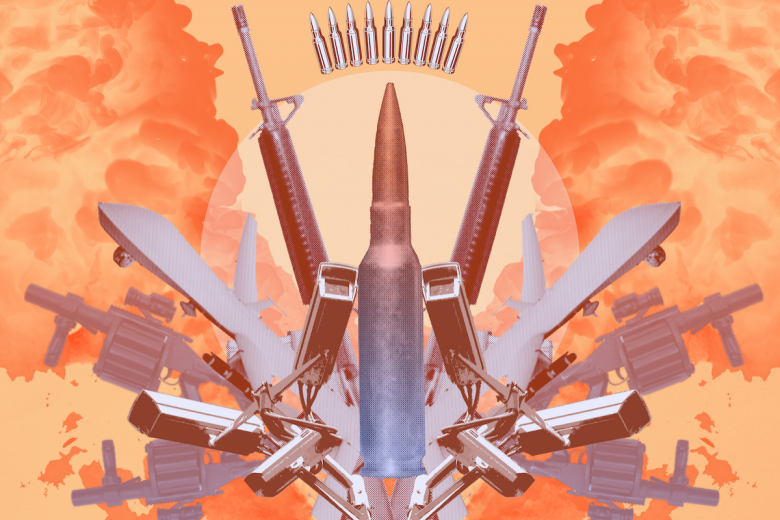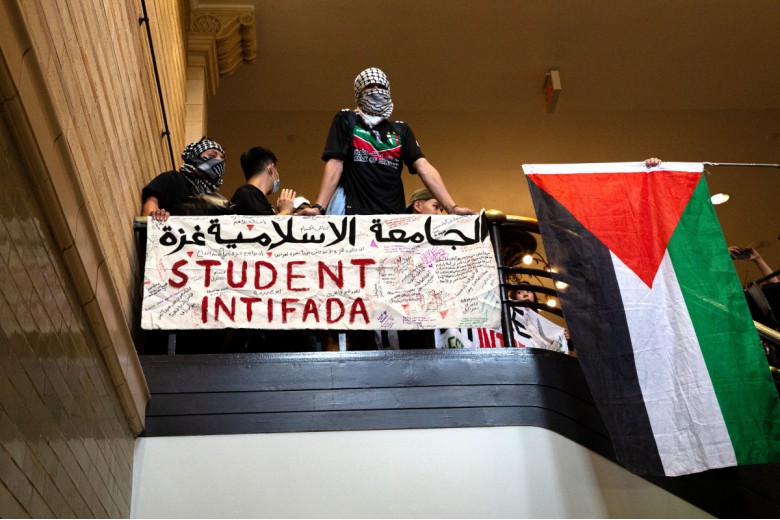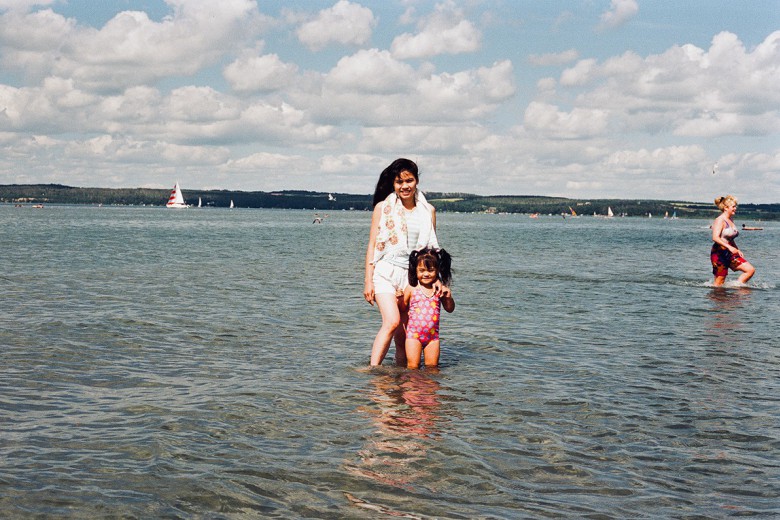By Anthony Fenton
December 2005/January 2006
“Neither imperialism nor colonialism is a simple act of accumulation and acquisition. It�s not just a matter of going out there and getting a territory and sitting on it. Both of these practices are supported and perhaps even impelled by impressive cultural formations, that include ideas that certain people and certain territories require and beseech domination.”
Edward Said, Culture and Imperialism
A Canadian helicopter hovers over Haiti’s Presidential Palace, May 20, 2004
At the 60th UN World Summit in October, the Canadian government figured prominently in hijacking the UN reform process in the interests of the powerful when it forced the UN General Assembly’s adoption of their new doctrine of humanitarian intervention, The Responsibility to Protect.
Contrary to the almost-universal praise the doctrine has garnered in the Canadian press, its adoption in fact raises very serious questions about the ends to which it will ultimately be put. Many fear its true purpose is to serve, not as a guarantor of human rights, but rather as a means of legalizing and legitimizing imperialist interventions in sovereign nations that dare to step outside the Washington (Free Market) Consensus. An examination of the “humanitarian” intervention in Haiti in February 2004 largely confirms these fears.
RESPONSIBILITY TO PROTECT’S adoption was trumpeted by UN Ambassador Allan Rock as “news all Canadians should join me in being proud of.” Oxfam International welcomed the Responsibility to Protect as an “historic measure to help prevent future genocides” and “an achievement worthy of the 60th anniversary of an organization set up to save generations from the scourge of war.” The Globe & Mail’s John Ibbitson said Canada has helped pave the way toward collective peace, while the Montreal Gazette’s editors called the formal recognition “that the human rights of citizens must trump the sovereign rights of governments” a “major step forward for the UN membership.”
For many years, however, dissident writers such as Noam Chomsky, Edward Herman, John Pilger and others have warned the public against the doctrine of “humanitarian intervention.” In 1999, Pilger referred to it as “the latest brand name of imperialism,” while Chomsky and Herman have discussed at length this “old wine in new bottles” as merely the latest means by which the great powers of the world – or in most cases, the world’s only superpower – paint a thin coat of legitimacy on what might otherwise be understood as naked acts of aggression against sovereign states.
Before the September 2005 UN World Summit, the idea of institutionalizing a legal mechanism for justifying one state’s violation of another state’s sovereignty on humanitarian grounds had been soundly rejected by such large blocs of countries as the Group of 77 and the Non-aligned Movement. These countries (representing the majority of the world’s people) rightly recognized that legalizing such a form of intervention would fatally undermine the otherwise inviolable right of state sovereignty, and thereby open the door to all manner of politically motivated interventions in poor countries under the veneer of “humanitarian intervention.” Interventions in Kosovo, Afghanistan, Iraq, and Haiti (in 1994 and again in 2004) are only the most recent examples of such so-called humanitarianism.
Haiti presents an instructive case study of what Responsibility to Protect means in practice. Haiti has been under control of a UN “stabilization force” since the February 2004 overthrow of its democratically elected government. At critical points leading up to the coup of February 2004, Canadian officials invoked the Responsibility to Protect as a possible means of resolving Haiti’s “political deadlock.” Indeed, a careful examination of these events allows us to see how the political crisis leading to the overthrow of Jean Bertrand Aristide was manipulated so as to provide the justification for a “Responsibility to Protect” intervention and long-term restructuring of the country in the interests of the US, France, and Canada.
The picture that is emerging of this “humanitarian” intervention allows us to better understand why the recent adoption of Responsibility to Protect by the UN General Assembly was met with such strong denunciations, most notably by Venezuela and Cuba, two countries that have refused to recognize Haiti’s post-coup government, and that have their own valid reasons to fear a military intervention legitimized by the UN on “humanitarian” grounds. Calling the Summit’s 35-page outcome document “invalid and illegal,” Venezuelan President Hugo Chavez lashed out at the Responsibility to Protect: “This is very suspicious…. Tomorrow or sometime in the future, someone in Washington will say that the Venezuelan people need to be protected from the tyrant Chavez, who is a threat…. They are trying to legalize imperialism within the United Nations, and Venezuela cannot accept that” (Associated Press, September 17, 2005).
IN 2000, CANADIAN FOREIGN Affairs Minister Lloyd Axworthy traveled to Washington for a “friends of Haiti” meeting with Madeleine Albright and other high-ranking diplomats. With Aristide’s victory all but guaranteed in the November 2000 Presidential elections, it was decided that the international community would impose a de facto economic embargo on the country due to minor irregularities in Haiti’s May 2000 legislative and parliamentary elections, which had been swept by Aristide’s Fanmi Lavalas party.
These “friends” of Haiti feared that unless Aristide’s Lavalas party was reigned in, the neoliberal vision for that country was in dire jeopardy. This is because, despite Aristide’s overthrow in 1991 and enormous pressure from these very same “friends,” Aristide’s party still insisted on putting the needs of Haiti’s poor ahead of Structural Adjustment Programs and Haiti’s small but powerful elite. Building schools, finding food, and prioritizing healthy care for Haiti’s majority poor did not resonate with policymakers in Washington and Ottawa.
Working under Axworthy at the time was MP Denis Paradis, who would later become Canada’s Secretary of State for Latin America and Minister responsible for La Francophonie. In early 2003, with the embargo against the hemisphere’s poorest nation taking its toll and a Haitian political opposition being nurtured by American, European and Canadian funding, Paradis hosted a high-level roundtable meeting at Meech Lake dubbed “The Ottawa Initiative on Haiti.” Diplomats from France, the OAS, Caricom, and the US attended. No Haitians were invited. Documents obtained through an Access to Information request suggest that subsequently, Paradis deliberately leaked the details of the meeting to his friend, reporter Michel Vastel, as a trial balloon to test public opinion on the subject of intervention.
The anti-Lavalas Haitian paper Observateur wrote on March 12, 2003:
“In an article by Michel Vastel that appeared in the magazine L’Actualite (March 15), it is said that Haiti will be put ‘under tutelage’ (a sort of trusteeship) of the United Nations, according to the principle of ‘Responsibility to Protect’…. Since the government of Brian Mulroney was at the forefront of the movement in 1994 to return Aristide to power in Port-au-Prince, the Jean Chretien administration considers it a duty to help change things in Haiti today. And it is finally admitted that the change can’t occur with Aristide. Thus, a plan has been devised, and Canada is in the lead, to replace Aristide this year, so that January 1st, 2004 may offer the occasion for a double celebration: The 200th anniversary of our first independence and a new attempt at building a truly democratic State.”
During an interview I conducted with Paradis months after the coup, he defended the 2003 meeting, while affirming that Responsibility to Protect was central to it:
“The idea of having this Ottawa meeting was to find ways to help the Haitian people…. Canada put together a group of experts and they did a report called ‘The Responsibility to Protect.’ When a state fails to give security of [sic] its people, is it not the responsibility of the international community to protect these people? It goes a little bit against the full autonomy of a country, but everything has to go through the United Nations…. After that, I would say that the thing went faster, and, as everybody’s aware, Aristide left.”
In mid-October of this year, after more than 16 months of post-Aristide “transition” government, the UN’s top human rights official referred to the situation in Haiti as “catastrophic,” affirming what independent human rights investigators have been reporting for some 20 months. (See www.ijdh.org.) The overthrow of Haiti’s elected government was immediately followed by a witch hunt and campaign of repression waged against supporters of Aristide and his Lavalas party. The initial phase of this “pacification” campaign was carried out while US, Canadian, French, and Chilean forces were on the ground. Flying in the face of Responsibility to Protect rhetoric, widespread and serious human rights abuses were being committed under direct UN supervision against a population that was still overwhelmingly pro-Aristide – one million people marched in support of his beleaguered government just three weeks before the coup. Literacy programs were shut down, subsidies for the poorest of the poor were eradicated, hospitals were closed – even a medical school built under Aristide was (and remains) occupied by foreign troops. Elected officials and popular leaders languish as political prisoners, and untold numbers of people have been killed, forced into hiding, or disappeared.
To date, no credible case has been made to justify the intervention in Haiti on grounds of Responsibility to Protect. Haiti’s “failure,” rather, was directly precipitated by Haiti’s elite and the international powers that would later step in as “protectors.” Interestingly, since the UN intervention no Canadian official other than Paradis has spoken of Haiti on grounds of Responsibility to Protect. Responsibility to Protect, it seems, was only useful as a rhetorical decoy in sowing the seeds of intervention; once the intervention happened, it was no longer necessary to invoke it. This was most clearly illustrated in the buildup to the World Summit in September, when a number of genocide survivors, international NGOs (Oxfam, Amnesty), and even Canada’s own Romeo Dallaire, were pushing Responsibility to Protect in the international media. Why weren’t any Haitians called upon to speak of Responsibility to Protect’s virtues?
When the doctrine was adopted by the Summit, few Canadian commentators went beyond superficial praise of the “major breakthrough” embodied in Responsibility to Protect’s adoption. In the Toronto Star, Richard Gwyn came the closest to criticizing it, describing it as a “liberal-imperialist doctrine.” He nevertheless asserts that Canadians should take some “national pride” in this new doctrine, however.
The Venezuelans and Cubans, on the other hand, complained of the “secrecy, exclusion and discrimination” of the manner in which it was propelled by a small group of 15 powerful countries, including Canada and the US.
Canadians have been led to believe that Canada is promoting democracy in Haiti, and that Responsibility to Protect is a progressive and humanitarian doctrine that, when applied, will only benefit the world’s majority. The reality, however, is that Canada, a leading player in both the de facto protectorate of Haiti and the international policing of Afghanistan, is now pitted against those whom George Bush and company have termed “them” in his “with us or against us” equation. Though the question has never been put to the people of Canada, we have chosen sides in America’s imperialist war-without-end. The forcing of Responsibility to Protect upon the world (it was adopted without a vote) only shows how desperate the Canadian ruling class is to maintain its well-worn veneer of benevolence, “honest-brokerism” and Canadian exceptionalism, even as Canadian interests become all the more deeply integrated with US imperial designs.
Anthony Fenton is an independent researcher, writer, and activist, and the co-author of Canada in Haiti: Waging War on the Poor Majority.






